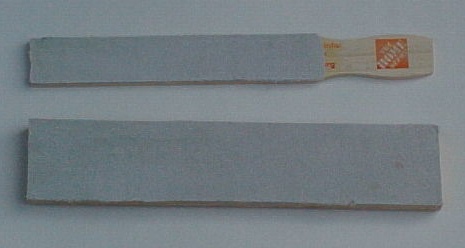
[Title] [text TOC] [image TOC] [Site Search]
 [Donation]
[Donation]

 [Donation]
[Donation]
 |
Strop |  |
|---|

| Materials | Tools |
|---|---|
|
2 wood 2"x12"x1/2" Leather 2 1/2"x12 1/2" Sharpening compound |
Pen Glue Rubber bands Vise or clamps Knife |
See the Wood Carving section for more instructions, hints, and tips.
Remember that carving with a sharp knife is fun, but with a dull knife it's work!
A strop is used to put the final polish on a knife blade to get it razor sharp. Once a knife is sharp, you should ONLY need to strop it to keep it sharp unless something drastic happens like you drop it. Strop a knife once or twice per hour while carving to keep that razor edge on it.
The size of the strop is not that important. I prefer a strop that is wide enough to do the whole blade at once. The wood from large paint stirs for 5 gallon cans can be obtained free from some home repair stores. It will be a little smaller than 2" wide, but still very useful.
The leather can be either the stamping or fabric variety. The stamping leather being harder is better. Even an old leather belt will work. You will be using the fuzzy side up to hold the sharpening compound.
There are several sharpening compounds available - aluminum oxide, silicon carbide, Yellowstone™, and Flexcut Gold™. I like Yellowstone™, but to each his own. A little will last a long time.
To glue the leather on use either wood glue or Gorilla Glue™. I use Gorilla Glue™ on rough wood as it fills in the valleys better. Be sure to read and follow the directions. Spread a line of glue near the edges and then spread it out evenly with a putty knife over the whole surface.
Here's how to make your own strop.
To use the strop, first lay it on a flat stable surface like a table; don't try to hold it in your hand. Place the strop on the edge of the table so you can hold the knife firmly and at the correct angle.
Clean the blade to remove any abrasives.
Woodcarving and kitchen knives have a long bevel; pocket knives have a short bevel. The idea is that you want to draw the bevel of the knife along the strop. If you hold the knife too flat, the edge won't get pressed against the strop and won't get polished. If you hold the knife at too great an angle, you will round the edge and dull the knife.
Hold the blade flat on the strop and barely lift the back edge up off the leather - try to match the angle of the bevel. If you have it too flat, you will feel the back edge digging into the leather. If you have it too steep, it will pull too easily. Experiment until you get the correct angle. This takes some practice. Then, pressing the blade firmly into the leather pull it back side first across the strop. If you push it blade first, the edge will cut into the leather. Lift the blade straight up off the leather to keep from rounding the edge. Remember that you are trying to remove metal, so push firmly.
Repeat this about ten times. Then turn the blade over and repeat the process for the other side. Use the same number of strokes on each side. It will take at least a minute or maybe several if the blade is very dull.
If the blade moves or rolls as you are stropping it, you will round the blade and it will not be as sharp. So hold the knife firmly and keep it as stable as possible.
To test the sharpness, carefully run the blade across the back of your hand and see if it will cut the hair. When it does, you've successfully sharpened the blade.
Pay special attention to the tip of the blade. The front 1/2" gets a lot more use especially if you are doing detail carving. You'll probably want to strop it more.
Some people like to do a final strop on just plain leather. You can add this to the other side of the board using the same technique as above. Make sure the wood is square and flat on both sides. Glue the fuzzy side of the leather down. Be sure to wipe the blade clean before stropping it on the plain leather. You don't want ANY abrasives on the leather.
Strop a blade for a minute or more if necessary a couple times every hour you are carving. You will need to do it more often when carving harder wood.
Be careful when stropping a pocket knife as the blade may tend to fold up on your hand. Place a finger or thumb on the very base of the blade to hold it in place.
Smoky Mountain Woodcarvers has a great page on sharpening.